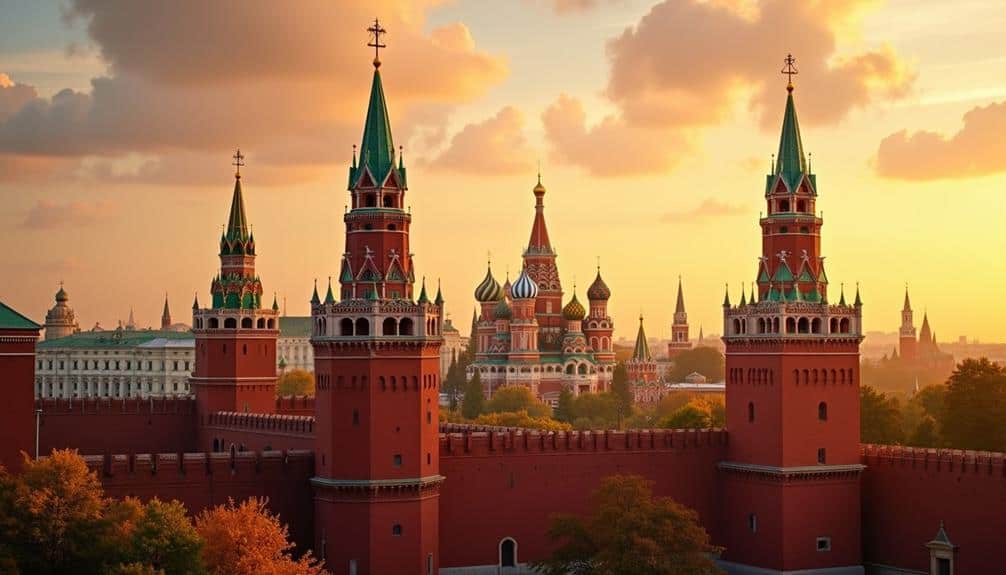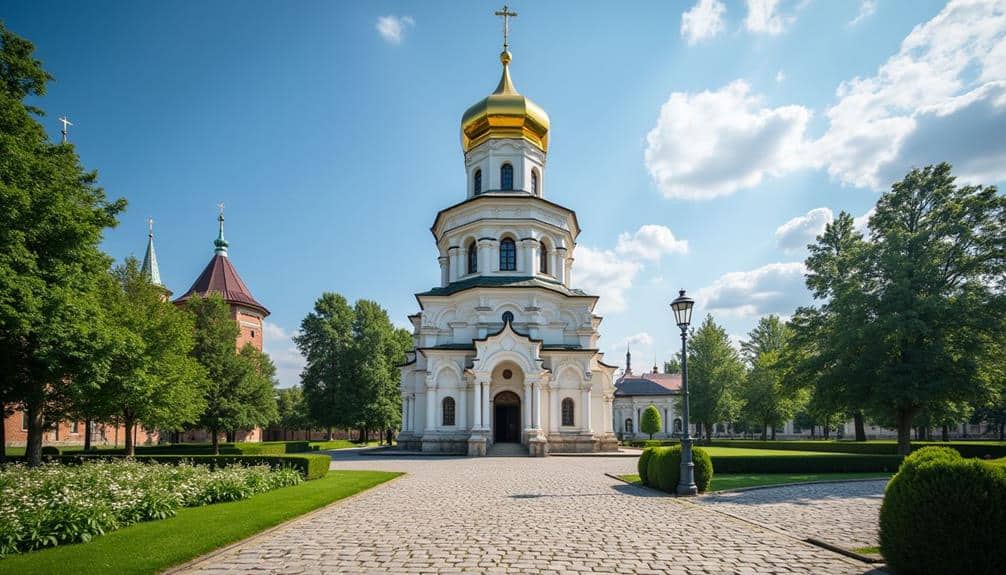Russia’s iconic tower landmarks serve as both historical monuments and symbols of architectural innovation, each with its own compelling narrative. The Kremlin Towers, with their intricate Russian Gothic design, stand in sharp contrast to the modern elegance of the Federation Tower, encapsulating centuries of artistic evolution. Meanwhile, the towering Ostankino Tower reflects Soviet-era ambitions, and the Ivan the Great Bell Tower underscores the deep religious roots of Russian culture. As we navigate through these monumental structures, one can uncover layers of history, artistry, and technological strides that continue to shape Russia’s skyline and cultural identity. What stories do these towering giants hold?
The Kremlin Towers

The Kremlin Towers, an integral part of Moscow’s historical and architectural heritage, epitomize the grandeur and resilience of Russian history. These iconic structures, numbering 20 in total, have stood as silent witnesses to centuries of political, cultural, and military evolution. Erected between the late 15th and early 17th centuries, the towers serve as both fortifications and symbols of Moscow’s enduring prominence.
The Kremlin history is rich with tales of power and intrigue, and its towers, each with unique characteristics, contribute considerably to this narrative. The Spasskaya Tower, for instance, holds historical significance as the main entrance to the Kremlin, adorned with the Kremlin Clock, which has become a symbol of Russian statehood.
Meanwhile, the Ivan the Great Bell Tower, the tallest of the Kremlin Towers, represents the architectural ingenuity of the era, combining both defensive and ceremonial functions.
The architectural significance of the Kremlin Towers cannot be overstated. Built mainly in the Russian Gothic style, they exhibit intricate brickwork and decorative elements that reflect the artistic trends of their time.
Collectively, these towers not only fortified the Kremlin but also elevated it to a status of architectural marvel, embodying the fusion of functionality and aesthetic grandeur.
Ostankino Tower
Rising majestically over the skyline of Moscow, Ostankino Tower stands as a tribute to Soviet engineering prowess and modern telecommunications. Completed in 1967, this towering structure was the world’s tallest free-standing tower until the completion of Toronto’s CN Tower in 1976. At 540 meters, Ostankino remains among the tallest structures globally, symbolizing the zenith of Soviet ambition during the Cold War era.
Ostankino history is deeply intertwined with the technological advancements of the Soviet Union. Designed by Nikolai Nikitin, the tower was intended to enhance television and radio broadcasting capabilities across the sprawling nation. Its construction utilized innovative pre-stressed concrete techniques, ensuring both stability and resilience.
The tower’s tapered, hyperboloid structure is not only visually striking but also functionally optimized to withstand severe weather and seismic activity. Ostankino architecture reflects a blend of aesthetic and pragmatic considerations.
The tower features a series of observation decks, the highest of which provides panoramic views of Moscow, drawing visitors from around the world. The tower’s base houses a museum dedicated to its engineering marvels, offering insight into the design and construction processes that defined this monumental achievement.
Ostankino Tower, consequently, remains a beacon of engineering ingenuity and a symbol of Moscow’s modernity.
Ivan the Great Bell Tower

While Ostankino Tower symbolizes Soviet-era technological advancement, Ivan the Great Bell Tower stands as a tribute to the grandeur of Russia’s historical and religious heritage.
Located within the Moscow Kremlin, this iconic structure was constructed between 1505 and 1508 under the guidance of architect Bon Fryazin. Serving as the tallest building in Russia for centuries, the bell tower reaches a height of 81 meters, embodying the architectural style of the early 16th century.
The Ivan the Great Bell Tower holds immense historical significance, acting as a central point of Moscow’s skyline and symbolizing the city’s religious devotion.
Its three-tiered design, characterized by white stone and gilded domes, reflects a blend of traditional Russian and Italian Renaissance architectural influences. The tower’s primary function was to house the bells of the Assumption, Archangel, and Annunciation Cathedrals, playing an essential role in both religious ceremonies and public announcements.
Throughout the centuries, the Ivan the Great Bell Tower has witnessed numerous historical events, including invasions, fires, and restorations.
Today, it remains a reflection of Russia’s enduring legacy, drawing both tourists and historians enthusiastic to explore its rich past and architectural splendor.
Spasskaya Tower
Standing proudly at the eastern wall of the Moscow Kremlin, Spasskaya Tower is one of Russia’s most renowned architectural marvels. Commissioned by Ivan III in 1491, the tower was designed by Italian architect Pietro Antonio Solari. Over the centuries, Spasskaya Tower has evolved into a symbol of Moscow and the Russian state.
Spasskaya history is rich with significant events. Initially serving as a defensive fortification, the tower also functioned as the main ceremonial gateway to the Kremlin. Its name, derived from the Russian word “Spas,” meaning “Savior,” is linked to the icon of the Savior, historically placed above the gates to protect the city.
During Napoleon’s invasion in 1812, the tower sustained damage but was subsequently restored, reaffirming its status as a resilient historical symbol.
Spasskaya architecture is distinguished by its ornate design and intricate details. The tower stands 71 meters tall, crowned with a ruby star added during the Soviet era. Its clock, the Kremlin chimes, is an iconic feature known for its precision and melodic tone.
The red-brick structure, complemented by white stone detailing, exemplifies the fusion of Russian and Italian Renaissance styles, making it a timeless masterpiece in Moscow’s skyline.
Federation Tower
Federation Tower, a striking example of modern architectural prowess, is a prominent feature of the Moscow International Business Center (MIBC). Comprising two skyscrapers—Tower East and Tower West—the complex stands as a demonstration of Russia’s aspirations in contemporary architecture and urban development.
Tower East, the taller of the two, reaches an impressive height of 373.7 meters, making it one of the tallest buildings in Europe.
The Federation history is intertwined with the rapid economic growth Russia experienced in the early 21st century. Construction began in 2003, and despite various delays, the towers were completed in phases, with the final touches on Tower East finished in 2017.
The design, conceived by Sergei Tchoban and Peter Schweger, reflects a seamless blend of glass and steel, symbolizing transparency and strength.
The architectural significance of Federation Tower lies in its innovative design and engineering. The towers are equipped with advanced seismic resistance technology, ensuring stability even during strong earthquakes.
Furthermore, the structure incorporates eco-friendly features, including energy-efficient systems and sustainable materials.
As a hub of commercial and residential spaces, Federation Tower not only enhances Moscow’s skyline but also embodies the city’s forward-thinking spirit.





